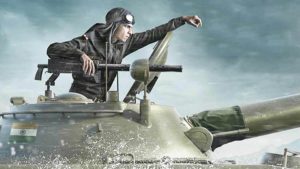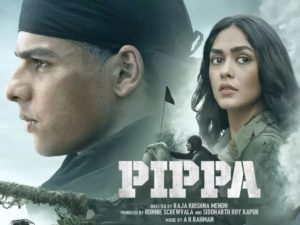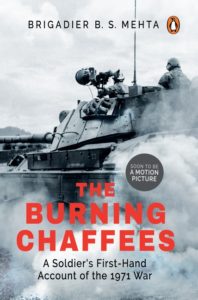Pippa (2003) – Disappointing
(All links in red are clickable links)
Dir: Raja Menon
Cast: Ishan Khatter. Mrunal Thakur. Priyanshu Painyuli. Abhinav Bhattacharjee.
Genre: War Drama
Platform: Amazon Prime
There is a long disclaimer before the main movie about the film being “inspired by real events on which creative liberty has been taken”. Perhaps such disclaimers are necessary, especially for Indian War FIlms. You will see why.
The 1971 Indo-Pak war remains a unique chapter in Indian history where a two-front war strategy was successfully followed and resulted in the birth of a new nation, Bangla Desh. The Western Front had more or less defensive actions in Rajasthan, Punjab and Kashmir. The Eastern Front was a different story. Attacking from multiple directions around East Pakistan, the Indian Armed Forces displayed a superb sense of combined operations and that intrinsic Indian essence of “jugaad” – using equipment far beyond their designed specifications, including the use of PT76 light amphibious tanks in major riverine operations. Local support of the Mukti Bahini liberation movement also helped get the Indian Army much-valued intelligence.
All these factors are shown authentically in the film. Then why is it so disappointing? The list is long, but first, let’s check the onscreen story.
Captain Balram “Balli” Mehta (Ishan Khatter) and his squadron are on an exercise testing the capabilities of the amphibious PT76 “light” tank. The tank can actually float and be driven on water, like a boat. Balli goes beyond the designated points and tests it even in deeper water against the orders of his superior officer, Major Daljit “Chiefy” Narang (Chandrachur Rai), but learns that the tank can be used in deeper waters. Celebrations follow the exercise.

Balli returns home in time to see his sister Radha (Mrunal Thakur), a veterinary student engaged to a dentist. His pranks and jokes are disliked by his elder brother Ram Mehta (Priyanshu Painyuli), who detests his layabout ways and irresponsible behaviour. Balli is posted back to Delhi, writing reports, as a punishment for not following orders. Ram is sent to a forward post and then on a reconnaissance mission with two Bengali speakers inside East Pakistan. Radha finds herself employed in a code-cracking agency, C&A, due to her interest in codes, as her Veterinary Professor’s son is also an expert in codes and cyphers. After the Army Chief Manekshaw (Kamal Sadanah) sees Balli’s modifications to the Pippa – the affectionate name for the PT76 – Balli is sent to the East Pakistan border to be with his squadron.
The Pakistani tanks invade, and the battle of Garibpur follows. In the meantime, Ram’s group of local guerillas have been ambushed by the Pakistani Army, and Ram is captured. Radha is tracking all the Pakistani codes being used in these areas.
Then, it becomes less about the battle of Garibpur and more about the Mehta family and how Balli’s impetuousness is ultimately beneficial. Balli’s coming of age? Certainly. Balli as a leader during wartime? Full marks. Balli as dancer supreme in the party scene? Full marks again.
As we can see, it is all about Balli the hero and his “herogiri” (In a seminar on Indian war movies, based on my book Lights Camera War, one of the participants used this term, and it perhaps best describes the “action” in the film). This “herogiri” includes rescuing his brother without any plan or authorisation ( what else do you think a hero is there for ?). Meanwhile, the elder brother stands up to the repeated physical torture by the (what else) ghastly Pakistanis and so we know how he and Balli will meet in the last reel.

If the film had stopped with the battle of Garibpur, it would probably have been a decent war film. Sadly, the “Herogiri” prevails. So, we are forced to watch the impossible proceedings. Let’s not forget Radha, who decodes the arrival of the US Seventh Fleet (the US 7th fleet was really ordered by President Nixon to support their allies, but the war ended much before their appearance in the Bay of Bengal). So, in short, like most Indian “war” films, it keeps getting sidetracked into the “relationship” angle. I leave it to your imagination as to what happens in the final reel.
While watching the film, I had a severe sense of déjà vu as I was reminded of the absolutely shallow Hindustan ki Kasam (1973). That one had a widowed mother, two Air Force officers who died on missions, and a sister who became a secret agent going behind lines in West Pakistan. Here, you have two Army Officers and a sister who is not exactly a secret agent but is involved in the secret world!
The impressive opening scene of the PT76 wading into the water and the battle scenes make up for it. Still, the Army advisers have seriously missed or overlooked technical goofs. By the 1971 war, the Indian Army had thrown away its WW2-era small arms. It was equipped with the locally produced 7.62 mm semi-automatic SLR and the fully automatic LMGs. Yet the film shows all soldiers equipped with the WW2-era 0.303 rifles (or at least wooden mockups) or AK47s, which entered service only in the early 1990s. . The all-black dungaree style uniform of the Armored Corps was introduced in the mid-1980s by then Army Chief of Staff K. Sundarji yet it is shown here routinely. The less said about the “Air attack”, the better. Before the actual war, everyone used the term Bangladesh while technically it was still East Pakistan.
In the real world, the Battle of Garibpur was unique as it was where Russian “Pippas” and American Chaffee “light” tanks crossed swords, with the Indian Pippas emerging victorious due to superior battlefield tactics. It was wonderful to see an actual working PT76 do its thing. The Visual Effects of “Multiple PT76s” doing a river crossing are excellent, and we can barely make out that it’s all digital.
 As mentioned earlier, it’s all about “Balli”. Ishaan Khatter holds up the film and does justice to his role of “punk turned sober hero”. It’s not his fault that the script deteriorates into “herogiri” every now and then. Kamal Sadanah in a tiny role as General Manekshaw is delightful. The pre-release publicity is full of fulsome praise from the real-life Balli Mehta, who retired as a Brigadier and wrote the book The Burning Chaffees (which is on my To Be Read pile – I wish I had read it before watching the movie).
As mentioned earlier, it’s all about “Balli”. Ishaan Khatter holds up the film and does justice to his role of “punk turned sober hero”. It’s not his fault that the script deteriorates into “herogiri” every now and then. Kamal Sadanah in a tiny role as General Manekshaw is delightful. The pre-release publicity is full of fulsome praise from the real-life Balli Mehta, who retired as a Brigadier and wrote the book The Burning Chaffees (which is on my To Be Read pile – I wish I had read it before watching the movie).
Pippa was announced in 2021 and was completed in 2022. That it went straight to OTT is a mystery – perhaps there is some internal wrangling we are unaware of. The cast unanimously says that the VFX took very long to produce! It is a pity, as the VFX can be only seen on a small screen and not on a large (theater) screen.
Music in a war film is always a mixed blessing. Main Parwana is undoubtedly designed to show Ishaan’s dancing skills. The dance scene is energetic while the song has a late 1960s-early 1970s feel to it. The rest of the time, the music is an interruption and doesn’t contribute anything to the movie or the story. (There is a protest today about how the “Nazrul Geet” is wrongly used in the film ) . So, on a lighter note, this seems to be a good argument to keep music and the song and dance routine entirely out of a war movie!
For those interested in the battle, here is the Wikipedia page on the Battle of Garibpur As mentioned earlier, it is perhaps a unique event of two “light” tanks from opposing Cold War camps clashing, and the “winner” is not from the “technically superior” side but the tactically superior side.
In short, watch it for the diluted history of the actual battle and the PT76 – if you are into both. . Pippa is on Amazon Prime
Real History – 3 out of 5
Special Effects – 3 out of 5
Script – 2 out of 5
Direction – 3 out of 5
Photography – 3 out of 5
Total – 2.8 out of 5